It makes for an exclusive group if its members do not include a pair of Grand Slam greats who own 45 singles majors collectively, a list which now includes Jannik Sinner and Aryna Sabalenka after their respective US Open triumphs.
Sinner’s convincing knockout blow of Taylor Fritz at Flushing Meadows on Sunday emulated Sabalenka’s straight-sets ledger against Fritz’s fellow first-time major finalist and compatriot, Jessica Pegula, a day earlier.
The results bookended the Grand Slam calendar for the Australian Open champions, something not even Rafael Nadal nor Serena Williams have managed in the same season.
Punishing schedules on and off the court expose major winners to potential mental and physical fatigue during a long season, while a hungry pack of increasing depth only complicates chances of snagging the first and final Grand Slams in any given year.
Sinner became only the fourth man since the Australian Open switched to hard courts in 1988 to win both hard-court Slams in a season after Roger Federer and Novak Djokovic, both three times, and Mats Wilander.
“I believe that you can't really compare them, because it's different circumstances, different times of the year,” Sinner said.
“I believe that in Melbourne was a kind of a relief, because in my mind it was like I was working for it, and you never know if you can win one Grand Slam or not, but when you win one, you know that you can do it potentially.
“Here was difficult because also the pre-tournament circumstances weren't easy. I felt like that I have grown match by match and that my confidence level went higher and higher at some point.
“It was different because I had more, maybe a bit more pressure this time than in Australia. I'm happy how I handled this one. Yeah, I'm just excited to have this trophy with me.”
The same two players triumphed at the two hard-court majors in the same season for the first time since 1988, when Wilander and Steffi Graf prevailed.
It was only the fourth time in the Open era the same pair collected the Australian and US Opens. Rod Laver and Margaret Court did so twice in 1969 and 1973.
After the Italian broke through for his maiden major at Melbourne Park in a bruising five-set comeback against Daniil Medvedev in January, it brought a whole new world of attention and commitments.
Back-to-back five-set defeats in the Roland Garros semifinals to his chief rival, spritely Spaniard Carlos Alcaraz, and to a score-settling Medvedev in the quarterfinals at Wimbledon followed a hip injury, while he missed the Paris Olympic Games due to tonsillitis.
Sabalenka, meanwhile, had the advantage of a year’s experience as a major winner when she returned to Rod Laver Arena in January, but her second Australian Open trophy came amid added pressure as defending champion.
The world No.2 had also rebounded through a troubling mid-season combination of personal heartache, illness in her Roland Garros quarterfinal defeat to Mirra Andreeva and a shoulder injury, which ruled her out of Wimbledon.
Like Sinner, she too missed the Olympics, and it could well have been a blessing in disguise as both headed to North America arguably fresher.
They picked up their first Cincinnati Masters/WTA 1000 trophy, respectively, which marked the second straight year both champions in Ohio then went all the way in New York after Coco Gauff and Djokovic.
Sabalenka, too, was in good company as just the fifth woman after Steffi Graf and Monica Seles, both twice, Martina Hingis and Angelique Kerber to complete the hard-court double since 1988.
“After I lost my father, it's always been my goal to put our family name in the history of tennis,” she said. “Every time I see my name on that trophy, I'm so proud of myself, I'm proud of my family that they never gave up on my dream and that they were doing everything they could to keep me going.
“So, I had this opportunity in life. It really means a lot. Yeah, it's been always my dream. I still kind of cannot believe that I was able to achieve, like me with my team, we were able to achieve so much already.”

